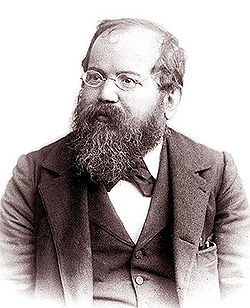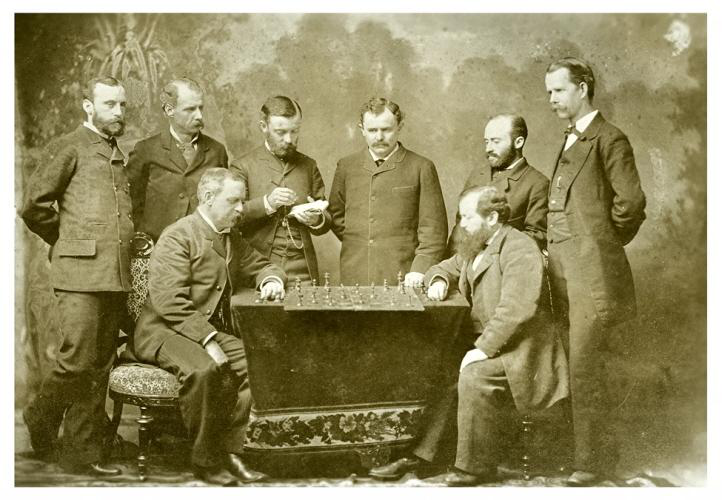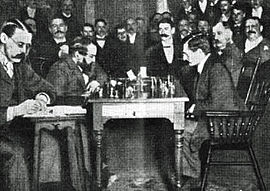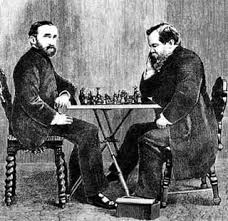Steinitz




Wilhelm (later William) Steinitz (May 17, 1836 –
August 12, 1900) was an Austrian-American chess player, the first official World
Chess Champion. He is considered to be the maker of the positional game, and
the one who laid the basis for modern chess game in cooperation with Paul
Morphy.
He was selected to the US Chess Hall of Fame in 1987,
and in 2001, to the members of the World Chess Hall of Fame.
Steinitz was born in the Jewish ghetto of Paris, as
the 13th, youngest child of the family. Wilhelm learned to play
chess at the age of 12 and began to play seriously in his twenties after he had
been to Vienna to study mathematics.
He won his first chess tournament in 1861, in Vienna.
Following that, he was sent to the London tournament representing Austria in 1862.
Although he finished sixth, the winner of the competition, Adolf Anderssen was fascinated
by Steinitz’s playing.
In 1866, he defeated Anderssen, who was the strongest active
player at that time. The match was characterized as a hard battle; after 12
games they stood by 6-6 then Steinitz won the last two games. After this win,
he was regarded as the best player of the world. He played several matches against
the then strongest players at the time (Bird, Blackburne, Fraser, Zukertort,
Winawer) and was not defeated.
According to the statistics in rankings we might assume
that he was one of the most dominant players in chess history. For 32 years, he
was never defeated (1862-1894.)
According to Chessmetrics historical rating, between September
1866 and May 1890 he stood on the top of the World Ranking in 173 different months
and his highest Elo score was 2826.
At the beginning, he had an aggressive style like his contemporaries.
When in 1873 he retired from practical game for nine years, he began to deal with
theoretical chess and introduced a new positional style. According to him, for the
win we do not need to start a total attack against the king. In those years, he
led the chess column of the British Chess
Magazine, The Field and explained
his new views that became the basis of modern chess.
Steinitz was a moderately productive author in chess
but his views were strongly criticized. However, he defended his new ideas, and
the debate became so bitter that the so-called "Ink War" burst out. His
character might have contributed to the situation: he was 1.5 m tall, lame, and
because he was quick-tempered, he always argued with other people. During the „Ink
War” Steinitz was the target of anti-Semitic abuses, therefore he left the continent
and moved to New York, USA.
In 1882, he returned to competitive chess and placed first
in Vienna, shared with Symon Winawer.
His match against Johannes Zukertort in 1886, when he
won by 10-5, was officially approved as a World Championship, thus Steinitz became
the first world champion. He defended his title for 8 years. During this period,
three attempts were made to win the title from him. He won twice against Mikhail
Chigorin: first in 1889 (ten wins, one draw, six losses) then in 1892 (ten wins,
six draws, eight losses). At 1890 Havana, he made a draw against Izidor
Gunsberg. The American Chess Congress did not repeat the event and Steinitz’s
last three games were arranged between the players so he could defend his title.
Then, in 1894, the 32 years younger Emmanuel Lasker,
who was relatively inexperienced at top level then, got the world champion title
from Steinitz. The match was played at three different venues: in New York, Philadelphia
and Montreal. Steinitz had previously claimed he would win without a doubt, so
he was probably very surprised when Lasker won the first game. Finally, in total,
Lasker won with ten wins, five losses and four draws and became the World Champion.
Three years later, in 1897, Steinitz lost the rematch too, and his strength
began to fade in the following years. Not much later he died in a mental health
institute.
Sources: https://hu.wikipedia.org; https://en.wikipedia.org; http://www.chessmetrics.com
